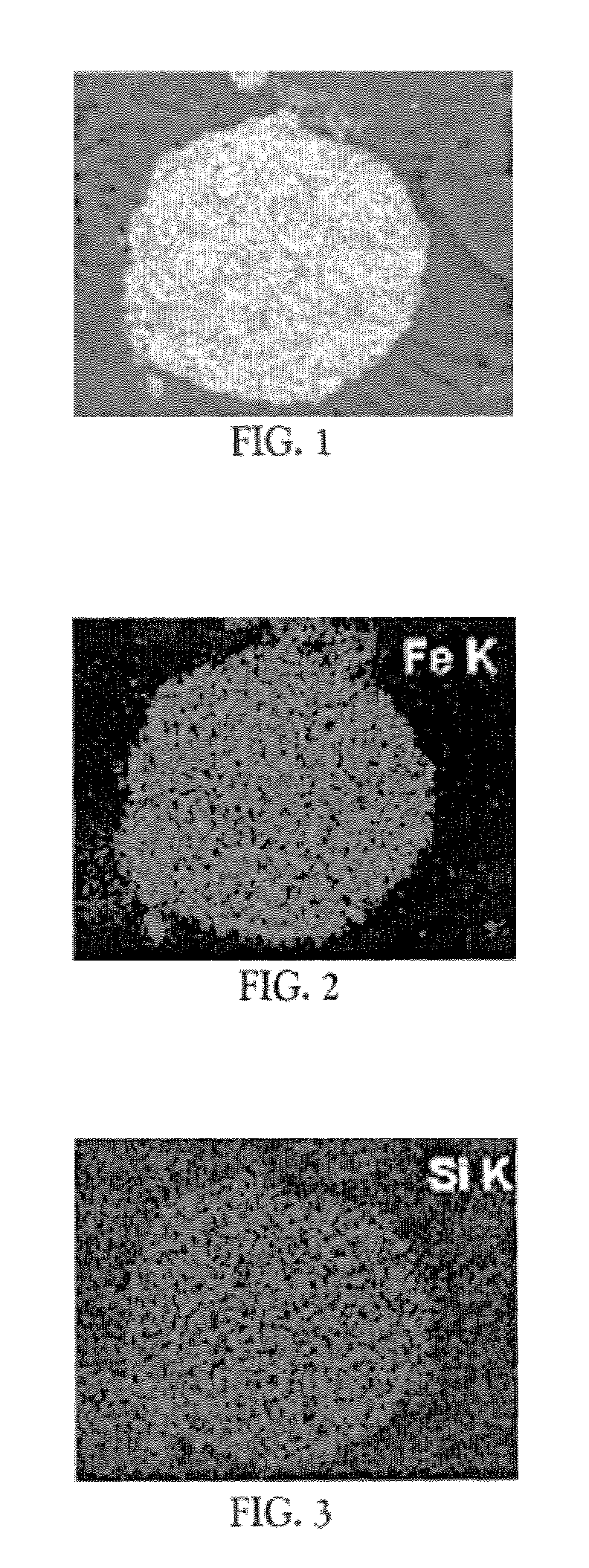Attrition resistant bulk iron catalysts and processes for preparing and using same
a bulk iron catalyst, attrition resistant technology, applied in the field of iron catalysts, can solve the problems of catalyst fines produced by abrasion during use, difficulty in separation of liquid/wax product from the catalyst, and attrition is currently a major obstacle, so as to improve the attrition properties, reduce the attrition loss, and improve the effect of attrition
- Summary
- Abstract
- Description
- Claims
- Application Information
AI Technical Summary
Benefits of technology
Problems solved by technology
Method used
Image
Examples
example 1
[Catalyst 27]
[0062]This example describes the preparation and testing of the Catalyst 27 [100Fe / 5Cu / 4.2K containing 4% binder SiO2 by weight] of the invention. The preparation comprises the following steps: synthesis of catalyst precursor, spray drying of the catalyst precursor and calcination.
[0063]The catalyst precursor was prepared by co-precipitation at a constant pH of 6.2 using 1.0-M solution containing Fe (NO3)3.9H2O and Cu (NO3)32.5H2O in the desired Fe / Cu atomic ratio, which was precipitated by adding aqueous ammonium hydroxide solution. The resulting precipitate was then filtered and washed three times with deionized water. The potassium promoter was added as aqueous KHCO3 solution to the undried, reslurried Fe / Cu precipitate. This catalyst precursor was then slurried with polysilicic acid solution in a ratio to produce a final catalyst composition having 4 wt % SiO2. The pH of the slurry was 6.4 before spray drying. A 3 feet diameter×6 feet high Niro Inc. spray dryer was ...
example 2
[Catalyst 28]
[0065]This example describes the preparation and testing of the Catalyst 28 [100Fe / 5Cu / 4.2K containing 8% binder SiO2 by weight] of the invention. The preparation comprises the following steps: synthesis of catalyst precursor, spray drying of the catalyst precursor and calcination.
[0066]The catalyst precursor was prepared by co-precipitation at a constant pH of 6.2 using 1.0-M solution containing Fe (NO3)3.9H2O and Cu (NO3)32.5H2O in the desired Fe / Cu atomic ratio, which was precipitated by adding aqueous ammonium hydroxide solution. The resulting precipitate was then filtered and washed three times with deionized water. The potassium promoter was added as aqueous KHCO3 solution to the undried, reslurried Fe / Cu precipitate. This catalyst precursor was then slurried with polysilicic acid solution in a ratio to produce a final catalyst composition having 8 wt % SiO2. The pH of the slurry was 6.4 before spray drying. A 3 feet diameter×6 feet high Niro Inc. spray dryer was ...
example 3
[Catalyst 30]
[0068]This example describes the preparation and testing of the Catalyst 30 [100Fe / 5Cu / 4.2K containing 12% binder SiO2 by weight] of the invention. The preparation comprises the following steps: synthesis of catalyst precursor, spray drying of the catalyst precursor and calcination.
[0069]The catalyst precursor was prepared by co-precipitation at a constant pH of 6.2 using 1.0-M solution containing Fe (NO3)3.9H2O and Cu (NO3)32.5H2O in the desired Fe / Cu atomic ratio, which was precipitated by adding aqueous ammonium hydroxide solution. The resulting precipitate was then filtered and washed three times with deionized water. The potassium promoter was added as aqueous KHCO3 solution to the undried, reslurried Fe / Cu precipitate. This catalyst precursor was then slurried with polysilicic acid solution in a ratio to produce a final catalyst composition having 12 wt % SiO2. The pH of the slurry was 6.4 before spray drying. A 3 feet diameter×6 feet high Niro Inc. spray dryer wa...
PUM
| Property | Measurement | Unit |
|---|---|---|
| Time | aaaaa | aaaaa |
| Density | aaaaa | aaaaa |
| Fraction | aaaaa | aaaaa |
Abstract
Description
Claims
Application Information
 Login to View More
Login to View More - R&D
- Intellectual Property
- Life Sciences
- Materials
- Tech Scout
- Unparalleled Data Quality
- Higher Quality Content
- 60% Fewer Hallucinations
Browse by: Latest US Patents, China's latest patents, Technical Efficacy Thesaurus, Application Domain, Technology Topic, Popular Technical Reports.
© 2025 PatSnap. All rights reserved.Legal|Privacy policy|Modern Slavery Act Transparency Statement|Sitemap|About US| Contact US: help@patsnap.com

